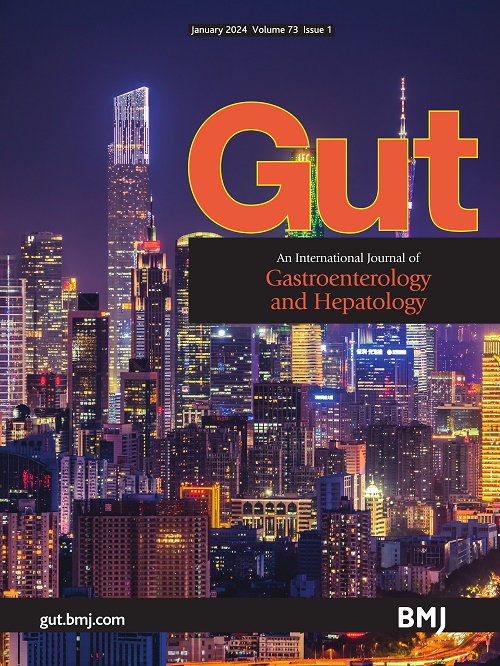Intrahepatic donor microbiota-based metataxonomic signature detected in organ preservation solution enables prediction of short-term liver transplant outcomes
IF 25.8
1区 医学
Q1 GASTROENTEROLOGY & HEPATOLOGY
引用次数: 0
Abstract
Background Liver transplantation (LT) remains hampered by post-transplant complications. While gut microbiota dysbiosis has been linked to transplant outcomes, the role of the intrahepatic graft’s native microbiota remains unexplored. Objective To characterise the microbial profile detected in organ preservation solution (OPS) and determine whether specific microbial taxa are associated with short-term clinical outcomes, and to develop predictive models for risk stratification. Design We analysed the OPS microbiota-based metataxonomic signature from 110 LT donors (discovery cohort) and an independent validation cohort (n=29) using 16S rRNA sequencing. Microbial DNA signatures associated with clinical outcomes were identified through MaAsLin2-adjusted models, and relevant gene pathways were uncovered via data mining and enrichment analysis. Machine learning (ML) models were developed to predict outcomes based on microbial features, and host–microbiome interactions were validated through RNA sequencing (RNA-seq of matched liver biopsies). Results OPS-derived microbial DNA signature closely resembled liver/bile microbiomes (Proteobacteria-dominated). Specific genera (eg, Bacillus , Prevotella ) were differentially abundant in adverse outcomes (p<0.05): hyperabundant in non-survivors and hepatic artery thrombosis, hypoabundant in acute rejection (AR). Gene mining linked these taxa to immune/metabolic pathways relevant to LT outcomes. RNA-seq validated upregulation of chemokines (CCL/CXCL families) in liver grafts from non-surviving recipients. ML models accurately predicted global survival (area under the curve (AUC)=0.95) and AR (AUC=0.96) based on microbial features, with generalisability confirmed in the validation cohort (AUC=0.85–0.88). Conclusion Donor intrahepatic microbial DNA signature predicts LT outcomes via immune-metabolic modulation. While causality requires further study, these findings position the graft microbiome as a novel biomarker and potential therapeutic target, paving the way for microbiome-informed precision care in transplantation. Data are available in a public, open access repository. Data are available upon reasonable request. All data relevant to the study are included in the article or uploaded as supplementary information. Microbial and transcriptomic datasets generated in this study have been deposited in the NCBI public repositories under BioProject accession numbers PRJNA1262407 (16S rRNA gene sequencing of preservation fluid) and PRJNA1262719 (RNA-Seq of pre-transplant liver tissue), respectively. The rest of data, analytical methodologies and research materials that support the findings of this study are available from the corresponding author upon reasonable request.在器官保存液中检测到基于肝内供体微生物群的元分类学特征,可以预测短期肝移植结果
肝移植(LT)仍然受到移植后并发症的阻碍。虽然肠道微生物群失调与移植结果有关,但肝内移植物的天然微生物群的作用仍未被探索。目的分析器官保存液(OPS)中检测到的微生物特征,确定特定的微生物类群是否与短期临床结果相关,并建立风险分层的预测模型。我们使用16S rRNA测序分析了来自110名LT供者(发现队列)和一个独立验证队列(n=29)的基于OPS微生物群的元分类特征。通过maaslin2调整模型确定了与临床结果相关的微生物DNA特征,并通过数据挖掘和富集分析发现了相关的基因通路。开发了机器学习(ML)模型来预测基于微生物特征的结果,并通过RNA测序(匹配肝活检的RNA-seq)验证宿主-微生物组相互作用。结果ops衍生的微生物DNA特征与肝脏/胆汁微生物组非常相似(以变形杆菌为主)。特定菌属(如芽孢杆菌、普雷沃氏菌)在不良反应中含量差异较大(p<0.05):在非幸存者和肝动脉血栓形成中含量高,在急性排斥反应(AR)中含量低。基因挖掘将这些分类群与与LT结果相关的免疫/代谢途径联系起来。RNA-seq验证了趋化因子(CCL/CXCL家族)在来自非存活受体的肝移植物中的上调。ML模型基于微生物特征准确预测了总体生存率(曲线下面积(AUC)=0.95)和AR (AUC=0.96),验证队列证实了其普遍性(AUC= 0.85-0.88)。结论供体肝内微生物DNA标记可通过免疫代谢调节预测肝移植预后。虽然因果关系需要进一步研究,但这些发现将移植物微生物组定位为一种新的生物标志物和潜在的治疗靶点,为移植中微生物组的精确护理铺平了道路。数据可以在一个公共的、开放访问的存储库中获得。如有合理要求,可提供资料。所有与研究相关的数据都包含在文章中或作为补充信息上传。本研究生成的微生物和转录组学数据集已分别以BioProject的登录号PRJNA1262407(保存液16S rRNA基因测序)和PRJNA1262719(移植前肝组织rna测序)存储在NCBI公共数据库中。支持本研究结果的其他数据、分析方法和研究材料可根据通讯作者的合理要求提供。
本文章由计算机程序翻译,如有差异,请以英文原文为准。
求助全文
约1分钟内获得全文
求助全文
来源期刊

Gut
医学-胃肠肝病学
CiteScore
45.70
自引率
2.40%
发文量
284
审稿时长
1.5 months
期刊介绍:
Gut is a renowned international journal specializing in gastroenterology and hepatology, known for its high-quality clinical research covering the alimentary tract, liver, biliary tree, and pancreas. It offers authoritative and current coverage across all aspects of gastroenterology and hepatology, featuring articles on emerging disease mechanisms and innovative diagnostic and therapeutic approaches authored by leading experts.
As the flagship journal of BMJ's gastroenterology portfolio, Gut is accompanied by two companion journals: Frontline Gastroenterology, focusing on education and practice-oriented papers, and BMJ Open Gastroenterology for open access original research.
 求助内容:
求助内容: 应助结果提醒方式:
应助结果提醒方式:


